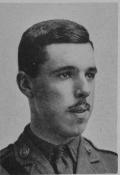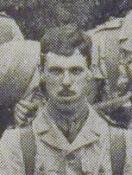
|
The King's School Canterbury |
Roll of Honour |
| Captain Charles Seymour PITTIS MC | |
|
1/8th (Isle of Wight Rifles) Battalion Hampshire Regiment Date of birth: 7th September 1895 Date of death: 19th April 1917 Killed in action aged 21 Buried at Gaza War Cemetery Plot XXI Row E Grave 7 |

|
| He was born at Hale Manor Farm, South Arreton on the Isle of Wight 7th of September 1895 the eldest son of Seymour Pittis, farmer, and Kate (nee Lock) of Hale Manor Farm. He was educated at Bedford House School in Folkestone and at the King's School Canterbury from January 1909 to July 1911 where he was a probationary scholar and a member of the Officer Training Corps. On leaving school he was articled to the solicitors A.Y. Young-Jones of Newport Isle of Wight, passed his Law Society Intermediate Examination in March 1914 and became a partner in the firm Roach Pittis. He applied for a commission in the 8th Battalion Hampshire Regiment (Isle of Wight Rifles) on the 10th of February 1913 and was commissioned as a 2nd Lieutenant in the battalion on the 20th of February 1913. He was mobilised with his battalion for war service on the 5th of August 1914. He was promoted to Lieutenant on the 20th of August 1914 and sailed from Liverpool on the 30th of July 1915 bound for Gallipoli where he landed with his battalion at Suvla Bay on the 9th of August 1915. On the 12th of August the battalion was ordered to an advance, with their objective being some huts about a mile ahead of their lines. They moved forward at 4.40pm but soon came under machine gun fire from their left flanks which inflicted a number of casualties. They advanced, meeting little opposition but the machine guns continued to take a toll and after an advance of 1,000 yards the move was a halted at Anafarta Wells where the survivors were finally forced to take cover in a ditch. Being only a small number they were forced to retire and joined others from their Brigade in a sunken track, holding this line until the 14th of August. On the 14th the Turks launched an attack against them and Charles Pittis' machine gun section caused a large number of Turkish casualties on the left of the line. The battalion was relieved that night. For his actions that day Charles Pittis was mentioned in Sir Ian Hamilton's despatches of the 11th of December 1915 and was awarded the Military Cross for the way he managed his machine gun section during the fighting there, an award which appeared in the London Gazette of the 2nd of February 1916. He was awarded his medal by the King in a ceremony at Buckingham Palace on the 8th of March 1916. On the 1st of September 1915 he was promoted to Temporary Captain and on the 6th of October he left his unit and was evacuated from ANZAC the same day suffering from enteric fever. He arrived in Gibraltar on the 15th of October 1915 where he spent some time being treated before he re-embarked on board the Hospital Ship "Egypt" on the 25th of November and landed in Southampton on the 29th of November 1915. He was taken to Parkhurst Hospital on the Isle of Wight where he received further treatment before being sent on leave from the 12th of December 1915 to the 11th of January 1916. On the 20th of May 1916 a Medical Board sat at Parkhurst which declared him as being fully fit for active service. Having re-joined his battalion, he was promoted to Captain on the 5th of July 1916 and was posted to Egypt where he was involved in the defence of the Suez Canal. In 1917 the invasion of Palestine began and it was during the 2nd Battle of Gaza that he was killed close to the Turkish trenches having attacked across open country under heavy rifle and artillery fire. He was twice mentioned in despatches. A brother officer and fellow OKS wrote:- "His rather shy and reserved manner covered a splendid character. He was not brilliant at games but he tried hard in both work and play, and was absolutely straightforward and thorough in everything he undertook and was ready to lend a hand to anyone who wanted his help. Besides two and half years with him at school, I have served under him in the ranks and I hold a commission in the same regiment; I know how popular he was with both men and officers, especially after active service had brought out his true worth. In the words of his men accidently overheard he was a "proper gentleman." His death was typical of him, steadily going forward in the face of great difficulties without flurry or excitement, until at the moment of getting the attack home he fell riddled with bullets. In our grief at his death our hearts go out in sympathy to his family." He is commemorated on the Arreton village memorial and on a bronze plaque commissioned by his parents on the south wall of the central chancel of St George's Church Arreton which was unveiled and dedicated at a service on the 4th of April 1918. He is also commemorated on the Arreton Roll of Honour, on the memorial at Newport Drill Hall on the Isle of Wight and on the memorial to the Isle of Wight Rifles at Carisbrooke Castle. His partner, Lieutenant Alexander Young Young-Jones of the same battalion was killed in action at Gallipoli on the 12th of August 1915. |
|
 | |
Back